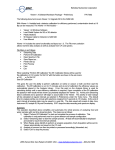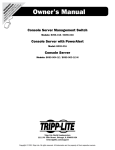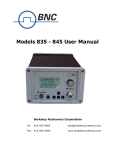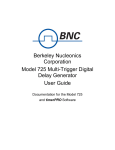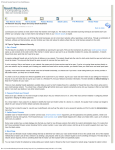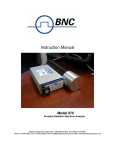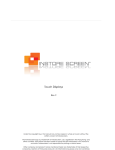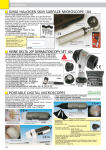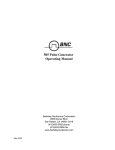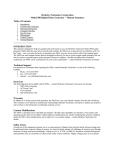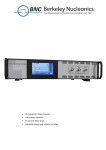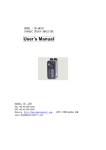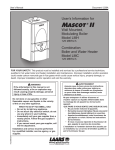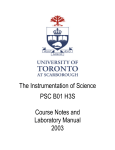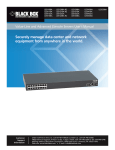Download USER MANUAL - Berkeley Nucleonics Corporation
Transcript
BERKELEY NUCLEONICS U S E R M A NUA L BNC™ MODEL 960 This manual covers installation and operation procedures for BNC™ AM members: Berkeley Nucelonics - 2955 Kerner Blvd. San Rafael, CA 94901 - (415)453-9955 - [email protected] Page |2 U S E R M A N UA L BNC™ MODEL 960 Table of Contents Chapter 1. Introduction.................................................................................................. 3 Functional description ..................................................................................................................... 3 Important safety information ......................................................................................................... 3 Product warranty .............................................................................................................................. 4 Chapter 2. Safety ............................................................................................................ 5 Caution and notes ............................................................................................................................ 5 Classification ..................................................................................................................................... 6 Label................................................................................................................................................... 6 Environmental requirements.......................................................................................................... 7 Chapter 3. Setup instruction .......................................................................................... 8 System components ......................................................................................................................... 8 Installation......................................................................................................................................... 9 Using key pad ................................................................................................................................. 10 Relay output configuration ........................................................................................................... 14 Strobe & horn configuration ........................................................................................................ 15 Chapter 4. Application Software ...................................................................................17 Network security(FIRE WALL) .................................................................................................. 17 Application Software ..................................................................................................................... 20 Chapter 5. Maintenance ............................................................................................... 25 Cleaning instruction ....................................................................................................................... 25 Appendix A: specifications .......................................................................................... 26 3|Page CHAPTER 1. INTRODUCTION FUNCTIONAL DESCRIPTION The BNC™ MODEL 960 is a member of the Model 960™ AM area monitoring system based on a GM sensor. It provides radiation dose rates in a convenient form factor with large display LCD panel. It is ideal for security and radiation monitoring in the laboratory, hospitals, isotope production facilities and other applications requiring remote, real-time 24/7 radiation monitoring. The unit is suitable for both on wall or flush wall installation. BNC™ AM members are based on Ethernet networking architecture and data management protocols that acquire data from multiple units generating local alarms and providing central command with comprehensive oversight and actionable alarm information. Figure 1. BNC™ MODEL 960 IMPORTANT SAFETY INFORMATION The BNC™ MODEL 960 has been meticulously engineered to provide safe, dependable, high performance to its user for years to come. But, as with any kind of electrical equipment, following instructions and taking basic precautions will prevent injury to yourself, the patient or to the equipment. Therefore, prior to using this equipment you should: • Read and adhere to the included unpacking and assembly document Page |4 • Read and understand this manual thoroughly. • Store all provided documents in a safe place for future reference. • Especially be sure to read the “SAFETY” chapter of this manual and thoroughly understand all warning and caution labels. PRODUCT WARRAN TY Description of the Berkeley Nucleonics warranty for the BNC™ MODEL 960 radiation area monitoring system: • The unit is warranted to be free of defects in material and workmanship, including: parts, labor and all unit elements. • Unless otherwise indicated, the warranty is good for 12 months after delivery to the original buyer only. 5|Page CHAPTER 2. SAFETY CAUTIONS AND NOTES The following warnings and instructions are vital to the optimal operation of the BNC™ MODEL 960 unit and should be made readily accessible for reference. Follow these warnings and instructions thoroughly to use the unit correctly and to protect the safety of both the patients and the users. Handling Instructions: • The operation and servicing of the unit should only be handled by qualified/trained personnel • To keep measurement errors at a minimal, always verify the validity of any measurement or test result. • Adjacent or stacked use of the unit should only be done when necessary. In such cases, configure the unit as it will be used and then verify normal operation. Safety Hazard Warnings: • It can be very hazardous to open the covers with the system plugged in on account of high voltage inside the unit (high voltage in the detectors are up to 1000 Volts). Be sure to refer all servicing to qualified/trained personnel. Disposal Instructions: • If/when disposing the unit: observe local and national regulations for the disposal of units containing lead. • If/when disposing the unit: observe local and national regulations for the disposal of units containing a lithium battery. • Do not use household of municipal waste collection services for disposal of electrical and electronic equipment. EU countries require the use of separate recycling collection services. Caution: • This equipment generates, uses and can radiate radio frequency energy and, if not installed and used in accordance with the instructions, may cause harmful interference to other devices in the vicinity. However, there is no guarantee that interference will not occur in a particular installation. If this equipment does cause harmful interference to other devices, which can be determined by turning the equipment off and on, the user is encouraged to try to correct the interference by one or more of the following measures: Reorient or relocate the receiving device. Page |6 Increase the separation between the equipment. Connect the equipment into an outlet on a circuit different from that to which the other device(s) are connected. Consult the manufacturer or field service technician for help.”If/when disposing the unit: observe local and national regulations for the disposal of units containing lead. WARNING: • External equipment intended for connection to signal input, signal output or other connectors, shall comply with relevant EN Standard • If, in doubt, contact qualified technician or your local representative. CLASSIF ICATION • BNC™ MODEL 960 is comply with EN61326-1:2006, 2_A1:2009+A2:2009, EN61000-3-3:2008 and EN61010-1:2010 EN61000-3- LABELS The label providing the system power requirements, contact information, MAC address and serial number of the system is located at the right-side of the unit. Figure 2. BNC™ MODEL 960 label 7|Page ENVIRONMENT REQUIREMENTS Operational To warrant reliability and accuracy of the instrument, the unit should be placed in a surrounding environment consisting of the following: • Temperatures range within +41°F to +100°F (+5°C to +38°C) • Maximum relative humidity is 10% to 80%. • A barometric pressure range of 27–31 inches of mercury (700–1,060 hPa). • Lowest possible and most constant background radiation Storage To warrant maximum reliability, the instrument should be stored in an environment consisting of the following: • Temperatures are stable and range from -40°F to +140°F (-20°C to +60°C) • The maximum relative humidity is 5% to 95% • Barometric pressure is within a range of 27–31 inches of mercury (700-1,060 hPa). Page |8 CHAPTER 3. SETUP INSTRUCTION SY STEM COMPONENTS BNC™ MODEL 960 and its components are shown in figure 3. The accessories are needed depend on options. Accessories include DC adaptor, Ethernet cable and 3 way strobe/horn with alarm LED and speaker. Figure 3. BNC™ MODEL 960 and its components 9|Page IN STA LL A TIO N BNC™ MODEL 960 is pre-configured and fully tested at the factory before being shipped. Therefore, it is ready to operate by simply connecting the power and turn the switch on. Figure 4 shows location of ports, keypad, display and alarm LEDs. Figure 4. BNC™ MODEL 960 label BNC™ MODEL 960 supports two power options. I.e., PoE (power of Ethernet) or DC. Note: In case of using an external strobe/horn, PoE is not supported. Only DC power option works. Note: In case of PoE power option, make sure to use a PoE supporting hub. Note: In case of “wall flush” installation, an in-wall mounting bracket and a cover are provided. Installation example is shown in figure 5. P a g e | 10 Figure 4. “Wall flush” installation example USING KEYPAD • Turn On message When MODEL 960 is turned ON, it displays following message. “Background Measurement in progress. Please wait…” It measures background radiation for a given time (defined in configuration setup as ‘averaging time’). Figure 5. BNC™ MODEL 960 turn on message. Background measurement procedure 11 | P a g e • Access to configuration menu Press ‘*’ on the keypad in order to access the configuration menu. The unit will ask 4 digit password as shown in figure 6. Note: Factory preconfigured default password is 0000. Figure 6. Access to the configuration menu example • Configuration menu screen MODEL 960 support 5 configurable parementers such as password, dose rate unit, alarm threshold and averaging time. Figure 7 shows configuration menu screen. 0: Change password 1: Select dose rate unit displayed. 2: Set alarm threshold for ALERT1 3: Set alarm threshold for ALERT2 4: Set average interval time 5: Exit When a number is pressed on the keypad from 0 to 5, it enters to a corresponding configuration screen. P a g e | 12 Figure 7. Configuration menu screen • Changing password Changing password example is shown in figure 8. Enter 4 digit number and reenter same 4 digit number to confirm. Then, press A for enter or B for cancel the change. Figure 8. Password changing example • Selecting dose rate unit displayed MODEL 960 support dose rate unit of uSv/h, uR/h, CPS, CPM. Selecting a number from the keypad. The factory preconfigured default unit is uSv/h. Note: If dose rate exceed uSv/h (or uR/h), the system automatically change the units to mSv/h or Sv/h (or mR/h or R/h). 13 | P a g e Figure 9. Selecting dose rate unit. • Setup alarm threshold MODEL 960 support two alarm levels, i.e., ALERT1 and ALERT2. Alarm threshold value can be from 1 to 100000 uSv/h. The default factory setup is 1 uSv/h. and 5 uSv/h for ALERT1 and ALERT2, respectively. Note: the threshold values must be ALERT1 < ALERT2. Otherwise, the system won’t accept the change. Figure 10. setup alarm threshold example (ALERT1 case) • Setup averaging interval time In general, GM tube requires averaging radiation activity over certain time period to average out spike-like signals which may cause false alarm. The averaging time ranges from 30 to 300 second. The factory default setup is 30 sec. P a g e | 14 Figure 11. Setup averaging time interval. RELAY OUTPUT CONFIGURATION MODEL 960 supports 3 relay output signals. i.e., normal, alert1 and alert2. It uses a DIN604 (6P) connector and its pin configuration is as follow: • Normal (Green LED): #5 • ALERT1 (Yellow LED): #4 • ALERT2 (Red LED): #2 • Ground: #7 15 | P a g e Figure 12. Relay output pin configuration: DIN-604(6P) STROBE & HORN CONFIGURATION External strobe & horn (D-SUB 9F) configuration is shown in figure 13. Its pin configuration is as follow: • Normal (Green LED): #5 • ALETR1 (Yellow LED): #4 • ALETR2 (Red LED): #6 • Ground: #2 P a g e | 16 Figure 13. Strobe & Horn pin configuration. The MODEL 960’s external Strobe & Horn has 3 way LED with speaker. And it is sync with status LED of main body. Figure 14 shows normal (green LED), alert1 (yellow LED) and alert2 (red LED). Figure 14. Strobe & Horn pin configuration. 17 | P a g e CHAPTER 4. APPLICATION SOFTWARE NOTE: Application software is an optional feature for the case that remote control and/or monitoring is required via Ethernet. NETWORK SECURITY (FIRE WALL) MODEL 960 uses both UDP and TCP network protocol. If it may not work properly because of OS SECURITY. Please make following changes. Note: Window security setup is out of program privilege, so if you have any problem, ask for computer manager and network manager. • To Configure Network Security 1. Select control panel and then run Fire wall. Figure 15. Windows control panel 2. Select Allowed Apps. P a g e | 18 Figure 16. Fire wall configuration window 3. Select Allow another app. Figure 17. Exception configuration window 19 | P a g e 4. Click on <browser> at Window then run AM100 execution file in MODEL 960 folder. Figure 18. Program execution file selection Note: Fire wall setup screen might be different depend on Windows OS version. Note: If you have any problem in Fire wall setup, ask for computer manager and network manager. P a g e | 20 APPLICATION SOF TWARE • Login procedure When running the software, login window appears as shown in figure 19. Enter valid ID with password. Factory preconfigured ID and password is ‘admin’ and ‘admin’, respectively. Note: The first time to login as admin, Please change the password for security. Note: Without password, you couldn’t run the program so you must remember the password. Note: If you forget about the Password, please re-install the program. Figure 19. Login window The main screen is shown in figure 20. It is divided into 5 fields, i.e. main menu bar, detector status, real-time activity, date/time and event log. Details of each function and usage is described in following sub chapters. 21 | P a g e Figure 20. Main screen • Detector status MODEL 960 application software can handle up to 4 units same time. The color of detector status icon indicates alarm status of each units. Color gray: offline, green: normal, yellow: alert1 and red: alert2, respectively. The alias name of each unit is displayed on top of the status icon. • Network setup Figure 21 shows network setup instruction. Select Network Setup from System menu. 1. Click <Search> button to search MODEL 960 units connected 2. Select a unit to setup network on the list box 3. Select static IP or DHCP protocol 4. In case of selecting static IP, define local IP and subnet address. P a g e | 22 Figure 21. Network setup window • Start Measurement 1. Click ‘Right-Mouse-Button’ on the detector status icon. Pop-up menu is appeared as shown in figure 22. 2. Select ‘Start” then real time activity graph start to display with assigned color. Figure 22. Real time activity display 23 | P a g e • Setup ‘group name’ and network ID 1. Select ‘Setting’ on the detector status icon. 2. Enter group name and IP address. And click Save button. Figure 23. Network setup window • Event Log display When alarm event occurred, the event is automatically saved in the database. Event Log menu is selected from the main menu to review past events. Figure 24 shows the event log window. P a g e | 24 • To view event log 1. Select date from the Date window “1” 2. Select time from the Event list window “2” Alarm event information such as alarm duration, average dose rate and maximum dose rate is displayed. And window “4” displays time activity of the selected alarm event. 25 | P a g e CHAPTE 5. MAINTERNACE CLEANING INSTRUCTION Use a soft cloth lightly dampened with water, window cleaner, or a mild detergent. Wipe the surfaces to remove dust or smudges. Other than general cleaning at the discretion of the user, there is no preventative maintenance required (see Cleaning Instructions above). The environment in which the tests must be performed should be where the temperature is stable within a range of +41°F to +100°F (+5°C to +38°C) and the maximum relative humidity is 90% non-condensing. Prior to performing any measurements the unit should be powered-up for at least one-half hour. No other precautions are necessary. Caution: The instrument may display erroneous readings if these environmental requirements are not followed. P a g e | 26 APPENDIX A: SPECIFICATIONS Dimension • Height 23 cm • Width 18 cm • Depth 6 cm • Weight 2 kg Detector • Energy compensated Geiger-Mueller Tube • Range: 0.1 mR/h to 1 R/h (MODEL 960-1), 1.0 mR/h to 10 R/h (MODEL 960-2) • Linearity: 10% of true value Input Power • DC Power (Standard) • PoE (optional) • Battery backup: > 12 hours, Li-ion overcharge protection Alarm • 3 level (normal, alert 1, alert 2) Display unit • uR/h, mR/h, R/h, uSv/h, mSv/h, Sv/h, CPS, CPM Environment Requirements The instrument should be located where the temperature is stable within a range of +5°F to +122°F (-15°C to +50°C) and the maximum relative humidity is 90% noncondensing for maximum reliability and accuracy.


























